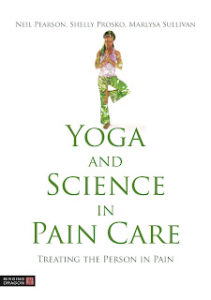
by Nina
A few years ago I interviewed Shelly Prosko about the book on pain management that she co-authored and co-edited with Neil Pearson and Marlysa Sullivan, Yoga and Science in Pain Care, for the Accessible Yoga blog. Recently, I realized that I had never shared the interview on the Yoga for Healthy Aging blog! So I decided to remedy that as soon as possible. After all, chronic pain is such a common problem and when used appropriately yoga can be so beneficial for those who are suffering from it. And for anyone who is suffering from chronic pain as well as for yoga therapists who are offering them help, learning as much as possible about yoga for pain care is extremely valuable. I hope this interview and hopefully the book we discuss here provide you with some helpful information.
Nina: Shelly, can you tell us a bit about yourself, including something about your professional background as a physical therapist, your yoga background, and what led you to become an expert in pain care.
Shelly: My journey of the integration of yoga in pain care started with my personal experience with yoga. The physical, emotional, mental, social, and spiritual benefits related to my personal yoga practice drove me to explore how yoga could be integrated into physical therapy to enhance patient care and outcomes, particularly for those patients who were struggling to find relief and ways to return to their most meaningful activities. Early on in my clinical practice, the necessity of taking a whole-person approach was evident. I quickly learned I was not treating conditions or addressing body parts; I was guiding a human being who was experiencing pain or living with or recovering from an injury or condition, within the context of their environment.
I also started learning about the emerging and more current science surrounding pain from a variety of resources, researchers, clinicians, and pain educators, including Lorimer Moseley, David Butler, and Neil Pearson. At the same time I was continuing my studies and exploration of yoga therapy. I found that yoga offered an incredibly inclusive, accessible, practical, and compassionate biopsychosocial-spiritual framework from which I could work while staying within my scope of practice as physiotherapist. This integration of yoga and science in pain care has helped me be more understanding, compassionate, effective, and creative in the way I guide and support people in pain to find an empowered way to live with more ease and peace.
Nina: There are already a few books out there on yoga for pain management, so can you tell us why you and co-editors/authors, Neil Pearson, and Marlysa Sullivan, decided to write Yoga and Science in Pain Care?
Shelly: The three of us are physical therapists, yoga therapists, continuing education providers, and clinicians who have been blending yoga and science into pain care in our professional healthcare practices for several years and witnessing the value that this integration provides. With the current global pain crisis and lack of effective approaches available for people with chronic/persistent pain, we wanted to offer something that could help improve pain care that would be accessible to both yoga and healthcare professionals and serve as a bridge between the two professions. We hope to help both parties gain an understanding about how yoga teachings and practices fit into pain care that is in line with current science, in hopes that yoga therapy could be seen as a respected, evidence-informed and viable approach in pain care. Throughout the book we outline the immense value, with supporting evidence, of this integration of yoga and science for healthcare and yoga professionals and for people in pain.
We also wanted to fill in the knowledge gaps surrounding pain, include the lived experience of pain as an essential part of understanding pain, people in pain, and pain science, include multiple perspectives, and offer a process of inquiry instead of a ‘how to fix’ recipe or ‘these 10 poses for back pain’ protocol book.
Nina: As I read through this book, I noticed that it seemed primarily intended for health care professionals and yoga therapists. But it also seemed to me that the average yoga practitioner who themselves is experiencing problems with pain, either acute or chronic, would benefit from reading at least some of the chapters in this book. What do you think?
Shelly: Absolutely. I have received emails of appreciation from yoga practitioners, yoga teachers, and people in pain who have read the book and found immense value in it. The first chapter, “The Lived Experience of Pain,” authored by a person in pain and pain advocate Joletta Belton, is remarkably profound and impactful. A patient I have been working with said that he related so intimately to Joletta’s experiences, that he could have written those words himself. He even asked his family members to read the chapter so that they could better understand where he was coming from.
Also, yoga practitioners and people in pain have expressed gratitude for and said they’ve found value in many other chapters in the book, like the pain biology chapter that describes the pain system, as well as the chapters on movement, breath and awareness, grief and loss, nutrition, addictions, psycho-emotional pain and the compassion and meaning/purpose in pain care chapters.
Nina: Could you talk a little about the two chapters that you wrote and how you chose these topics?
Shelly: I wanted to write the breath chapter because I have seen the profound shift even a simple breath practice can make in one’s pain experience and relationship to pain. I had previously created a yoga course on the value of breath and breathing practices for overall health and wellbeing, so I wanted to expand on that content and include how breathing practices specifically can help people in pain.
For the compassion chapter, as I listened to stories from people in pain, learned from the leading pain educators, and read research surrounding pain, the messages became more and more clear: when pain persists in an individual, the person can start to experience feelings of self-blame, shame, anger, anxiety, guilt and become self-critical.
But research shows that self-compassion can be an antidote to these feelings and experiences and that it can be trained. Also, compassionate care by the health professional (which includes self-compassion within the health professional) has vast benefits that I outline in the chapter, including mitigating practitioner burnout.
Nina: Can you give us a quick overview of why working with the breath and pranayama are so helpful in pain care?
Shelly: Overall, breathing practices can be an accessible, easy, safe and effective treatment strategy to modulate pain. They also give the person in pain a sense of self-efficacy and empowerment in their pain care. Working with the breath can serve as a powerful tool to provide insights into one’s current physiological state and can be a profound agent of change.
Nina: And how about compassion? Why is this so important?
Shelly: Compassion is the foundation of “care,” pain care and healthcare in general. There are numerous benefits to providing compassionate pain care, which includes some obvious benefits for the person in pain, but also benefits for the health provider. Yet, some national surveys suggest it is lacking in different regions of healthcare around the world. The good news is that compassion is a skill that can be trained and that yoga is inherently a compassionate practice and can also prime us for our compassionate wisdom to emerge in the context of any situation.
In “Compassion in Pain Care,” I outline how yoga teachings and practices can be used to cultivate compassion and self-compassion both for the person in pain and the healthcare/yoga professional in hopes that we can all experience the benefits that the research shows compassion can result in, and ultimately improve pain care for the person in pain and promote health and longevity for the health/yoga professional.
Nina: Is there anything else you’d like to say to our readers?
Shelly: I think one of the most impactful things we can all do is to ensure that we listen to and validate the stories of people in pain, and to recognize the individual living with pain as the expert in their pain experience. The more we can learn about pain from the person’s lived experience and from what the current science is telling us about pain, the better chance we have of successfully guiding and serving people in pain. It is my hope that our book can help you on this path of learning and illustrate how and why yoga can be such a powerful approach in pain care.
Readers! If you would like to buy Yoga and Science in Pain Care by Neil Pearson, and Marlysa Sullivan, along with several of their esteemed colleagues, and you can find it at Indie Bound, Barnes and Noble, and Amazon, or ask your local bookstore to order it for you. In Canada you can find it at Singing Dragon and in the UK, you can find it at Amazon UK.

Shelly Prosko, PT, C-IAYT is a physiotherapist, yoga therapist, pioneer of PhysioYoga, and educator with over 20 years of experience integrating yoga into physiotherapy and working with people in pain. She teaches in physiotherapy and yoga programs, presents at yoga and medical conferences globally, contributes to academic research and writing, and offers onsite and online courses for yoga and health professionals. Shelly is a Pain Care U Trainer and is co-editor/author of the textbook Yoga and Science in Pain Care: Treating the Person in Pain. She maintains a clinical practice in Sylvan Lake, Canada. Visit www.physioyoga.ca.
• Follow Yoga for Healthy Aging on Facebook and follow Nina on Instagram • Pre-order Yoga for Times of Change: Practices and Meditations for Moving Through Stress, Anxiety, Grief & Life’s Transitions here • Order Yoga for Healthy Aging: A Guide to Lifelong Well-Being here


Leave A Comment